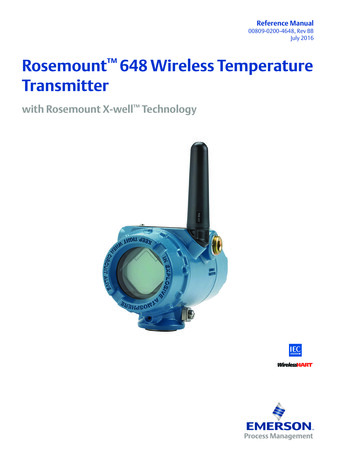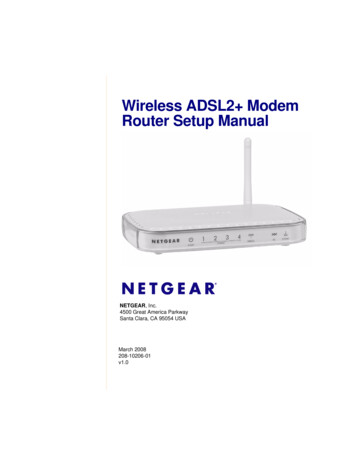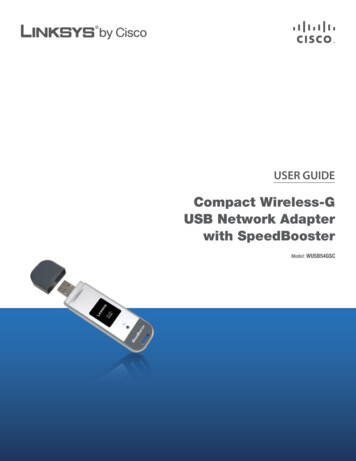
Transcription
Lecture notes for 15.564: Information Technology IWireless Communications Wireless telephony Wireless LANs Location-based services1The Technology: Radio Spectrum Radio Spectrum: from 30 KHz to 3 GHz AM radio: 540KHz – 1800 KHzFM radio: 88 MHz – 108 MHzCellular (e.g. AMPS): 824 – 849, 869 – 894 MHzCellular (e.g. GSM): 890 – 915, 935 – 960 MHzPCS frequencies: 1800 – 2200 MHz Microwaves: from 3 GHz to 300 GHz Infrared Spectrum: from 300 GHz to 300 THz2Chrysanthos DellarocasPage 1
Lecture notes for 15.564: Information Technology IThe electromagnetic spectrum3Issue: Spectrum is a scarce resource!Possible Solutions: Frequency reuse (cells) Multiplexing4Chrysanthos DellarocasPage 2
Lecture notes for 15.564: Information Technology IHow a cell phone works5Cellular Phone Networks Frequencyreuse Handoff6Chrysanthos DellarocasPage 3
Lecture notes for 15.564: Information Technology ICellular Phone Networks Frequencyreuse Handoff7Cellular Phone Networks Frequencyreuse Handoff8Chrysanthos DellarocasPage 4
Lecture notes for 15.564: Information Technology IProblem: Reuse not good enough! Radio waves attenuate at a rateproportional to the square of distance(1/r2) This means that faraway cells areirrelevant but we still can haveinterference from adjacent cells Therefore, a cell cannot reuse the samechannels as its 6 immediate neighbors This means that each cell can only use1/7th of the spectrum allocation Example: AMPS system Each operator was given 416 2-way channelsbut could only use about 416/7 60 channelsat any given cell9Multiple Access Technologies FDMA: Frequency Division Multiple Access TDMA: Time Division Multiple Access Each call occupies a different frequency and has anexclusive use of that frequency during the callSeveral calls can share the same frequency byalternating in timeCDMA: Code Division Multiple Access Multiple calls mixed together; each call spread over theentire available spectrum; calls can be reconstructed byusing call-specific keys.10Chrysanthos DellarocasPage 5
Lecture notes for 15.564: Information Technology ITDMA: Time Division Multiple AccessTDMA - Time Division Multiple AccessCellularphone 1Cellularphone 1e3Message 1Message 2Message 3Time Slot 1Time Slot 2Time Slot 3MCellularphone 3Cellularphone 2Cellularphone 3Cellularphone 211TDMA Dual-Mode Capability 3x the capacity of analog networks 6 time slots per channel 30 kHz Channel Spacing 2 time slots per mobile uplink Tx 832 Channels downlink Rx 8 kbps (Full Rate Mobiles) 3 calls per channel30 kHz ChannelTime Slot 1Time Slot 2Time Slot 3Time Slot 4Time Slot 5Time Slot 6lot 2Time Slot 1Time Slot 3Time Slot 2Time Slot 5Time Slot 4Time Slot 612Chrysanthos DellarocasPage 6
Lecture notes for 15.564: Information Technology ITDMA 4 Kbps (Half Rate Mobiles) 6 time slots per channel 1 time slots per mobile–handles both uplink Tx/ downlink Rx 6 calls per channel30 kHz ChannelTime Slot 1Time Slot 2Time Slot 3Time Slot 4Time Slot 5Time Slot 61313CDMA: Code Division Multiple AccessCDMA - Code Division Multiple AccessCode 1Cellularphone 1MessageCode 3Code 2MessageMessageCellularphone 3Cellularphone 2Code 3VoicePacketsMessageCode 1Code 2MessageMessage14Chrysanthos DellarocasPage 7
Lecture notes for 15.564: Information Technology IFrequency Hopping Spread SpectrumShort duration hops between radio frequencies Sender and receiver know sequenceFrequency Slots 806040200012345678Time17Random number generators Simplest approach is to use the followingrecurrence sequence:x0xn 1 P1xn P2(mod N)n 0,1,2,.For example:P given,1 16807, P 2 0, and N 231-1 2147483647Basic property: If P1, P2 known, then different choices of the initialseed x0 result in completely distinct sequences Therefore, the seed x0 can act as the code, to beexchanged between sender and receiver18Chrysanthos DellarocasPage 9
Lecture notes for 15.564: Information Technology IHistory of CDMA Co-invented byactress Hedy Lamarrduring World War II asa technique againstinterference ofsubmarinecommunications She was inspired bythe musical notesencoded on the scrollsof a player piano19Summary of multiplexing methods20Chrysanthos DellarocasPage 10
Lecture notes for 15.564: Information Technology IAdvantages of CDMA Spread Spectrum Analysis 1.23 MHz channel vs. 30 kHz Each call is distinguished by a unique digital codedifferent from others users transmitting at the samefrequency band 10 times the capacity of analog networks Lower Power Terminals/Longer Battery Life2121Generations of mobile phone technologies 1G 2G 2.5G 3G22Chrysanthos DellarocasPage 11
Lecture notes for 15.564: Information Technology IHistory First Generation: Analog Second Generation: Digital GSM (1st Europe, then world-wide)Digital AMPS (IS-54)2.5: PCS AMPS (USA)NMT (Europe)DCS-1800 (world-wide except USA)DCS-1900 (USA)CDMA (IS-95, USA)Third Generation: Personal Communication Systems UMTS23Migration of Digital CellularSystemsCircuit-Switched VoiceCircuit-Switched Packet-Switched Data Packet-SwitchedGSM Circuit-Switched VoicePacketDataGPRSEDGEIS-136 Circuit-Switched VoicePacket Voice & Dataover EDGEIS-136 EDGEGPRS: General Packet Radio Service(17.6 kbps x 8)EDGE: Enhanced Data for GSMEvolution(59.2 kbps x 8)UMTS: Universal Mobile TelecommSystemsUMTSCDMA2000Packet Voice & Dataover UMTS (WCDMA)24Chrysanthos DellarocasPage 12
Lecture notes for 15.564: Information Technology IGeneral Packet Radio Service (GPRS) Extension to GSM to support packet transmission Transmission rates: 57.6 and 115.2Kbpsinitial rates will be lower: 20-30 Kbps Good integration with the TCP/IP protocol Cingular Wireless deploys GPRS network in SanFrancisco/San Jose in March 2001; uses Ericsson’s 520handsets25Summary26Chrysanthos DellarocasPage 13
Lecture notes for 15.564: Information Technology IWireless LANs and PANsMajor developments: IEEE 802.11 standard for wireless LANs Home Radio Frequency Spec (HomeRF) BluetoothWireless LAN industry will grow from 300M in 1998to 1.6B in 2005 (Frost & Sullivan)27IEEE 802.11 Standard Operates in 2.4-2.4835GHz frequency band 2 standards: unlicensed band for industrial/scientific/medical appsoriginal 802.11: transmission rates 1-2Mbps802.11b (High Rate): transmission rates up to 11Mbps (actualdata transmission rate is about 7Mbps)Transmission distances: top transmission rates achieved within 150 ft;1Mbps rates can be achieved within 1000 ft;signals can be transmitted through walls28Chrysanthos DellarocasPage 14
Lecture notes for 15.564: Information Technology IAdvantages of 802.11b network access freedom for mobile workers cost-effective network setup for hard-to-wirelocations (e.g., old buildings) reduced cost of ownershipespecially when frequent network changes requiredTotal economic benefits can add up to 16K per user(“WLANs : ROI/Cost-Benefit Study,” WLANA, Oct 1998)29Wireless LAN Applications Earlier applications: mostly vertical manufacturing facilities, warehouses, retail stores, carrentalsMore recent applications: healthcare facilities (bedside access to patient info bydoctors),educational institutions (e.g., Stern - study groupmeetings, research links)corporate offices (on-site consultants, database accessfor roving supervisors, customer info)30Chrysanthos DellarocasPage 15
Lecture notes for 15.564: Information Technology IBluetooth A PAN – has a set of wireless protocols; enablesdevices to communicate within 10m distance. Transmission rates: 432.5Kbps (both ways forsymmetric transmission) 721/57.6 Kbps (asymmetric transmission) 1300 companies support Bluetooth (12/1999) Applications: cars, homes, wireless phones31Bluetooth Consortium: Ericsson, Intel, IBM, Nokia,Toshiba - many members Scenarios connection of peripheral devices support of ad-hoc networking bridging of networks- loudspeaker, joystick, headset- small devices, low-cost- e.g., GSM via mobile phone - Bluetooth - laptop Simple, cheap (target 5/device), replacement of cables and IrDA, lowrange, lower data rates 2.4 GHz, FHSS, TDD, CDMA32Chrysanthos DellarocasPage 16
Lecture notes for 15.564: Information Technology IPiconets and Scatternets Each piconet has one master and up to 7 slaves Master determines hopping sequence, slaves have tosynchronize Participation in a piconet synchronization tohopping sequence Communication between piconets devices jumpingback and forth between the piconetspiconets33Bluetooth Applications Wireless PDAs always connected to desktop viamobile phone Wireless headphones connected to notebook Office/Home device networks that automaticallyreconfigure by presence 34Chrysanthos DellarocasPage 17
Lecture notes for 15.564: Information Technology IBluetooth Success Factors Low enough cost Existence of wideband, circuit-switched mobilenetworks Currently 25-50, will reach 5 at 2003-4Depends on 3G mobile developmentsStandardized software protocols still mostly on paper!35Summary36Chrysanthos DellarocasPage 18
Lecture notes for 15.564: Information Technology ILocation-based Services: Definition“Location-based services (LBS) are anyactivity conducted over a cellular networkwhere the accurate determination of auser’s position is fundamental to theenabling of that activity”(Yankee Group)37Cell-ID old technology cell size varies from 100m radiusto 35km radius still: sufficient accuracyfor many applications38Chrysanthos DellarocasPage 19
Lecture notes for 15.564: Information Technology ITime Difference of Arrival (TDOA) calculates difference in arrival timeat pairs of cell sites requires two pairs, i.e. threedifferent cell sites clocks at cell sites need to besynchronized39TDOA Implementation Existing antennas can be used Additional device (clock,measurement unit)installed in each base station40Chrysanthos DellarocasPage 20
Lecture notes for 15.564: Information Technology IAngle of Arrival (AOA) only two base stations required complex antenna array inprecise pattern cost and practical issues(zoning regulations) accuracy degrades over distance mainly used to supplement TDOA in areas whereonly two base stations are available41Enhanced Observed Time Difference Cursor EOTD by CPS inUK beta trial with Vodafone Requires 3 Base stationand Location MeasurementUnit Promises under 50mprecision with 3G Location circles by computing time delta betweenBTS and handset vs BTS and LMU. Intersection of 3 circles gives location42Chrysanthos DellarocasPage 21
Lecture notes for 15.564: Information Technology IAssisted GPS Snaptrack (Qualcomm) Increased sensitivityreceiver allows for GPStracking even when no lineof sight Cell location sends requestfor snapshot from relevantGPS satellite Limitations within buildings Combines precision of GPS with information givenby cell ID to achieve rapid location43A Classic Example of Standards WarPrecisionMarket stageLocation fixNetworkModificationsHandsetModificationsE911 complientCell Id100m to 30 kmProven3 secNoneNoneNoTDOA/AOAE-OTDA-GPS100 to 250m50 to 125m5 to 50mBetaBeta200210 sec5 sec3-5 secClockLocationNoneMeasurement MeasurementUnitsUnits orAntennasNoneSoftwareHardware:installation GPS enabledunitsYesYesYesDifficult to predict the emerging standardthe real winner might be upstream in the value chain44Chrysanthos DellarocasPage 22
Lecture notes for 15.564: Information Technology ILocation-Based Service CategoriesInformationYellow pagesNavigation servicesTraffic informationTrigger ServicesTrackingFleet ManagementAsset TrackingPeople TrackingLocationServicesSafetyEmergency ServicesRoadside AssistancePersonal SensitiveBillingEntertainmentGaming45Chrysanthos DellarocasPage 23
Lecture notes for 15.564: Information Technology I Wireless Communications Wireless telephony Wireless LANs Location-based services 1 The Technology: Radio Spectrum Radio Spectrum: from 30 KHz to 3 GHz AM radio: 540KHz - 1800 KHz FM radio: 88 MHz - 108 MHz Cellular (e.g. AMPS): 824 - 849, 869 - 894 MHz Cellular (e.g. GSM): 890 - 915, 935 - 960 MHz
